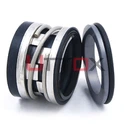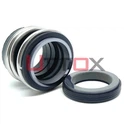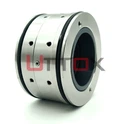1. Shaft seal box
In the past, the shaft seal box that contained the mechanical seal was a stuffing box designed for soft packing seals. It is not suitable for holding mechanical seals, not only the size is too small, the gap is too narrow, but also the simple cylindrical shape is not suitable.
Foreign countries have formulated standards for enlarged-sized mechanical seal shaft seal boxes. In addition, the United States_Duramitelec and the British Fluid Mechanics Research Group are both studying reasonable mechanical seal shaft seal boxes, whose shape should not only be conducive to fluid flow and heat dissipation, but also conducive to the removal of solid particles. Sealing creates a good surrounding environment.
2. Emission control of volatile matter
In the past, only attention was paid to the elimination of visible fluid leakage, and no attention was paid to the control of the invisible volatile matter, which caused environmental pollution and was dangerous to equipment and people. Foreign countries such as the Seal Technical Committee of the American Society of Tribology and Lubrication Engineers have formulated SP-30 (1994), SP-32 (1990) and SP-33 (1991) for easy control of rotating machinery, compressors and screw systems with mechanical seals. Guidelines for emission regulations. SP-30 is implemented in three phases. It clearly stipulates the definition of blocking fluid and buffer fluid, and clarifies the concepts of error and confusion. The blocking fluid is a fluid that is introduced between the double seals to completely block the leakage of the process fluid to the surrounding environment. The pressure of the blocking fluid is always higher than the pressure of the process fluid being sealed. The buffer fluid is the fluid used as a lubricant or buffer between the double seals. The pressure of the buffer fluid is always lower than the pressure of the sealed process fluid.
3. Auxiliary system matching
The auxiliary system of the mechanical seal has cooling, heating, flushing and other systems that need to be matched, the pump circulation needs to be optimized, and the status monitoring system is under study and solution. The matching of auxiliary systems is specified in the API-682 standard.
4. Gas blocking sealing system
In the past, liquid blocking liquid or liquid blocking gas was commonly used in blocking and sealing systems. In order to simplify the huge blocking liquid system, blocking gas was used to block liquid or gas blocking. The sealing system can use spiral groove gas seal and blocking gas, floating sleeve and blocking gas, etc. To block gas and liquid.







